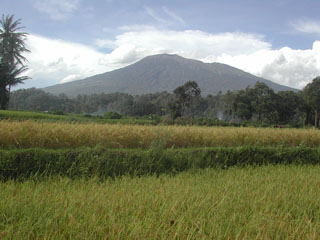Report on Marapi (Indonesia) — April 1979
Scientific Event Alert Network Bulletin, vol. 4, no. 4 (April 1979)
Managing Editor: David Squires.
Marapi (Indonesia) 60 killed by air fall of coarse tephra
Please cite this report as:
Global Volcanism Program, 1979. Report on Marapi (Indonesia) (Squires, D., ed.). Scientific Event Alert Network Bulletin, 4:4. Smithsonian Institution. https://doi.org/10.5479/si.GVP.SEAN197904-261140
Marapi
Indonesia
0.38°S, 100.474°E; summit elev. 2885 m
All times are local (unless otherwise noted)
According to press reports, 60 persons were killed by an eruption of Marapi during the morning of 30 April [but see below], and rescue workers searched for 19 others believed trapped by "landslides." The volcano was said to have ejected "stones" and "mud" or "lava," causing damage in at least five villages. The deaths were apparently caused by large airfall tephra.
Geological Summary. Gunung Marapi, not to be confused with the better-known Merapi volcano on Java, is Sumatra's most active volcano. This massive complex stratovolcano rises 2,000 m above the Bukittinggi Plain in the Padang Highlands. A broad summit contains multiple partially overlapping summit craters constructed within the small 1.4-km-wide Bancah caldera. The summit craters are located along an ENE-WSW line, with volcanism migrating to the west. More than 50 eruptions, typically consisting of small-to-moderate explosive activity, have been recorded since the end of the 18th century; no lava flows outside the summit craters have been reported in historical time.
Information Contacts: AFP; Kompas, Jakarta.

